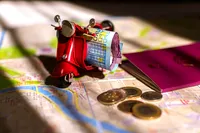Currency in Philippines
What Currency Does Philippines Use Now

The Philippines, with its beautiful beaches, world-class dive spots, thriving city life, and its rich history, is fast becoming one of the must-visit destinations in Asia.
When planning your adventure to the Philippines, it is crucial to know about the country's currency system. They use the Philippine Peso (PHP) as their national currency. It's represented by the symbol "₱".
Bills range from 20 Pesos, 50 Pesos, 100 Pesos, 200 Pesos, 500 Pesos, to 1000 Pesos, while the coins range from as low as 1 Peso up to 10 Pesos. They also have centavo coins that come in 1 Centavo, 5 Centavos, 10 Centavos, and 25 Centavos values. The currency denominations are colorful and have different prominent Filipino personalities and natural wonders imprinted on them.
It is important to be aware that exchanges outside the country usually don't accept Philippine peso, so you would need to exchange your money either when you arrive or in your home country using online services.
Credit and Debit Cards in the Philippines

The Philippines is still predominantly a cash-based society. However, the use of credit and debit cards is becoming more common, especially in major cities. Most shopping malls, hotels, and upscale restaurants accept credit and debit cards, with Visa and MasterCard being the most widely accepted, followed by American Express and JCB.
However, it's still best to have cash on hand, especially when travelling outside city areas. Small establishments, public transport, and street vendors do not have card facilities and only accept cash.
It’s also worth mentioning that while card usage is becoming more commonplace, you may occasionally encounter issues with card machines, especially in more remote locations. Therefore, having a mix of cash and a card is the safest option.
Using Cash in the Philippines

Using cash is probably the most straightforward and hassle-free way of buying goods and services in the Philippines. Cash is universally accepted, and you won't need to worry about a retailer's card machine not working or high foreign transaction fees on your credit or debit card.
While the convenience of using cash is clear, it's essential to keep your money safe. Pickpocketing can happen, more so in crowded areas. It's always advisable to carry only the money you expect to spend for the day and to keep it in a safe place.
Additionally, be mindful when accepting changed - counterfeiting, while not rampant, does exist. Familiarizing yourself with the country’s currency and always asking for a receipt can protect you from falling victim to such scams.
ATMs in the Philippines
ATMs are plentiful in the city areas and most towns in the Philippines. The country's major banks, including Bank of the Philippine Islands (BPI), Metrobank, and Banco de Oro (BDO), operate extensive ATM networks. International cardholders can typically withdraw from these ATMs with the Maestro, Cirrus, Visa or Mastercard logos on it.
However, keep in mind that foreign cards generally attract a fee for each withdrawal, and exchange rates from ATMs may not be as favorable as those through currency exchange providers. Hence, it's best to withdraw larger amounts less frequently to avoid piling up fees.
Bank Hours
Bank hours in the Philippines typically run from 9:00 AM to 3:00 PM from Monday to Friday. Some branches, especially those found in shopping centers, also open on Saturdays and extend their business hours until 4:00 or 5:00 PM.
For emergencies or sudden needs, banking services are also available 24/7 through the banks' online platforms and ATM machines.
Remember, when planning a trip to the Philippines, be prepared with a plan for accessing your money. While credit and debit cards are increasingly accepted, cash remains the most prevalent form of payment, particularly in more remote or less-developed regions. Plan ahead to get the most out of exploring this beautiful and exciting country!
